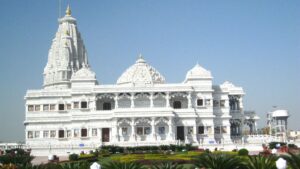Jaipur is one of the major tourists destinations in India. Jaipur serves as a gateway to other tourist destinations in Rajasthan and has some of the best places to visit in Rajasthan along with two World heritage Sites, Amer Fort and Jantar Mantar.
Also known as Pink City for its trademark building colors, Jaipur evokes the royal family that once ruled the region. Founded by Sawai Jai Singh in 1727, Jaipur is one of the earliest planned cities of modern India, designed by Vidyadhar Bhattacharya.
During the British colonial period, the city served as the capital of Jaipur State. After Indian independence in 1947, Jaipur was made the capital of the newly formed state of Rajasthan in 1949. Lets explore the best places to visit in Jaipur once you land here.
Major Tourist Attractions in Jaipur
1. Amber Fort

Amber Fort, also known as Amer Fort was the bastion of the Kachwahas of Amber, until the capital was moved to the plains, to what is today Jaipur.
The palace, located in craggy hills, is a beautiful melange of Hindu and Mughal styles. Raja Man Singh I began the construction in 1592 and the palace, which was built as a strong, safe haven against attacking enemies, was completed by Mirja Raja Jai Singh.
Made entirely of red sandstone and white marble, visitors are left spellbound by the magnificence of the palace that utilizes carvings, precious stones and mirrors.
The splendor of the palace is enhanced by the breath taking vista of the Maota Lake in front. The palace is nearly seven centuries old and has a legendary past.
Originally a small structure that the Rajputs won from the Meena tribes, it was later transformed into the grand Amber Palace and is one of the best places to visit in Jaipur today.
2. City Palace

Located deep within the walled city, the City Palace Complex was conceived and built by Maharaja Sawai Jai Singh II, the founder of Jaipur. A beautiful fusion of Mughal and Rajput architecture, the palace is still home to the last ruling royal family which lives in a private section of the palace.
Maharaja Sawai Jai Singh II is credited with building most of the structures, but it was expanded upon by later rulers as well.
The City Palace Complex includes the Mubarak Mahal (the palace of reception) and the Maharani’s Palace (the palace of the queen). Mubarak Mahal now houses the Maharaja Sawai Man Singh II Museum and displays a vast and unique collection of royal costumes, delicate Pashmina (Kashmiri) shawls, Benaras silk saris, and other dresses with Sanganeri prints and folk embroidery.
The clothes of Maharaja Sawai Madho Singh I are also on display. The Maharani’s Palace, surprisingly, has an interesting display of very well-preserved Rajput weaponry, some dating back to the 15th century. Other than the arms, the palace is adorned with beautiful paintings on the ceiling that are well-maintained.
3. Hawa Mahal

Hawa Mahal, literally the Palace of Winds, was built in 1799 by the poet king Sawai Pratap Singh as a summer retreat for him and his family. It also served as a place where the ladies of the royal household could observe everyday life without being seen themselves.
This unique five-storey structure is a blend of Hindu and Islamic architecture, and the exterior, with its small latticed windows (called jharokhas), resembles the crown of Lord Krishna. The windows also serve as an air-conditioner of sorts, blowing cool air throughout the palace, making it the perfect retreat during summers.
Built from pink sandstone, the Hawa Mahal is Jaipur’s iconic landmark and visitors can view its complete magnificence from outside, from across the road. However, it is also possible to climb right up to the top for a wonderful view from the windows. Today, the Mahal is maintained by the Archaeological Department of the Government of Rajasthan and also houses an archaeological museum in the courtyard.
4. Jantar Mantar

Now a UNESCO World Heritage Site, Jantar Mantar in Jaipur is considered to be the largest of the five astronomical observatories built by Maharaja Sawai Jai Singh II, the founder of Jaipur. It contains sixteen geometric devices, designed to measure time, track celestial bodies and observe the orbits of the planets around the sun.
It also houses the Interpretation Centre that helps the tourists to understand about the working principles & chronology of the observatory.
5. Nahargarh Fort

Nahargarh Fort sits proudly on a ridge of the Aravalli Hills, creating an impressive northern backdrop to the city of Jaipur. It was constructed during the reign of Jai Singh in 1734, and was later expanded in 1868.
Nahargarh, which means abode of tigers, was a formidable barrier, defending Jaipur against attacking enemies. Within its walls, the fort houses Madhavendra Bhawan, the summer destination for the members of the royal family.
Built by Sawai Madho Singh, the palace has 12 matching boudoirs for the queens, at the head of which is a suite for the king. They are all connected by corridors decorated with delicate murals. Even today the palace is a favored spot for local picnickers.
The fort looks brilliant when floodlit at night. Overlooking the city, it presents a glittering view of the city lights.
6. Albert Hall Museum
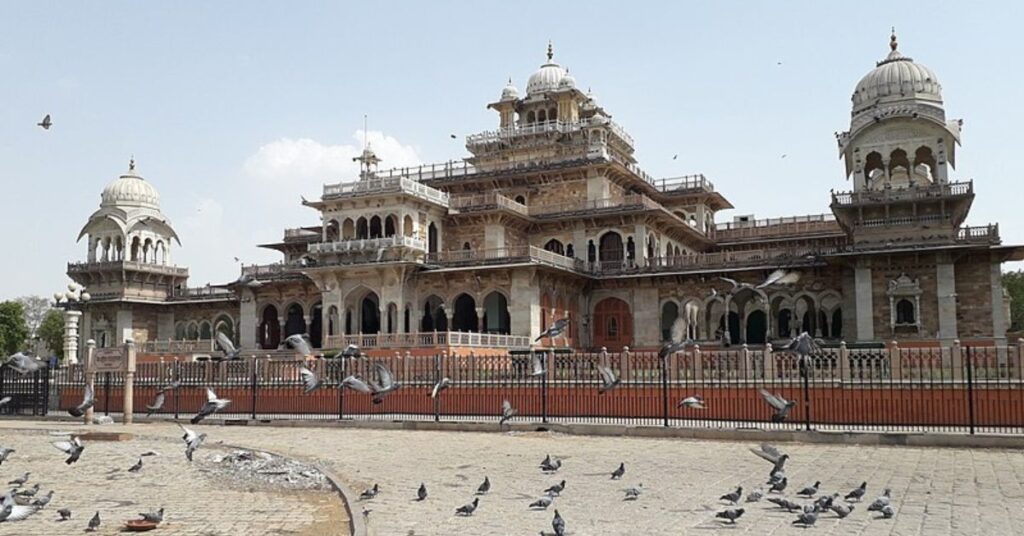
The building gets its name from The Victoria and Albert Museum in London, the inspiration for its design. The exquisitely built Albert Hall is housed in the Centre of Ram Niwas Garden. Sir Swinton Jacob (who is also the mastermind behind many other palaces in Rajasthan) conceptualized and designed it using styles from the Indo-Sarcenic architecture and the Prince of Wales laid the foundation stone of the building in 1876.
The museum displays a wide range of metal objects, wood crafts, carpets, stone and metal sculptures, arms and weapons, natural stones and ivory goods. It also houses a large collection of miniatures from Bundi, Kota, Kishangarh, Udaipur and Jaipur schools of art.
7. Jaigarh Fort
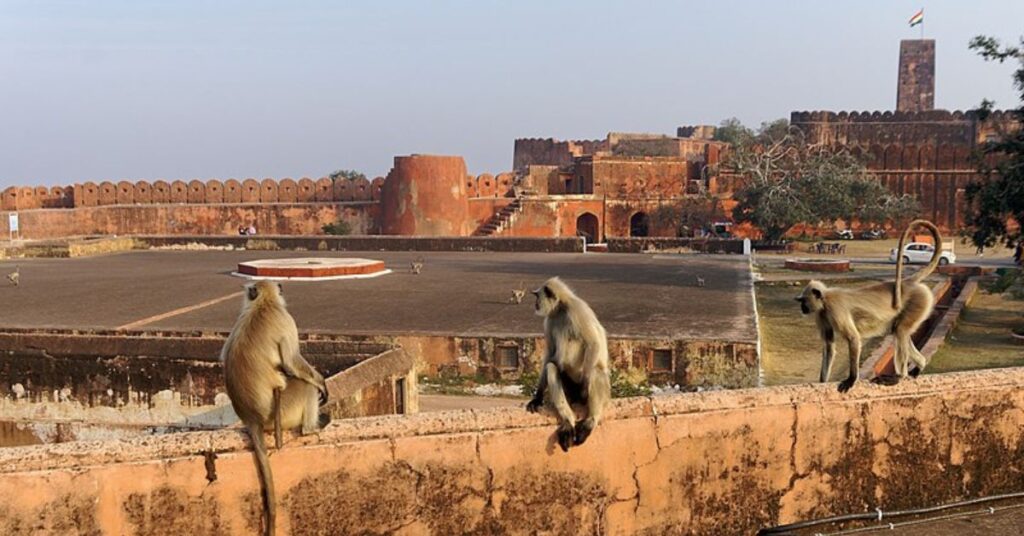
About 15 kilometers from Jaipur, Jaigarh Fort was built by Sawai Jai Singh II sometime in the early 18th century amidst the arid, rocky and thorn-scrub covered hills. Despite its ancient construction, it still retains most of its imposing citadel appearance. Visitors can see the world’s largest cannon – Jaiban, at the fort.
8. Birla Temple

The Lakshmi-Narayan Temple, or the Birla Temple, as it is more popularly known as, is located at the base of Moti Dungari. Built on an elevated platform, this comparatively modern temple is built entirely of white marble and dominates the skyline of south Jaipur.
Birla temple was commissioned and built by renowned Indian industrialists, the Birla’s, in 1988. The temple is dedicated to Lord Vishnu, also called Narayan, and his companion, Lakshmi, the Goddess of wealth and good fortune.
The temple is a work of art and has a marvelous display of exquisite carvings and sculptures covering many mythological themes. The eye is drawn to the images of Laxmi and Narayan, carved as they are, from one piece of marble. Top of the temple has three domes, each representing the three religions followed in India. This is designed to pay homage to secular India.
Birla temple looks spectacular at night when it is lit up. Other than the main temple, the complex has a museum that exhibits the earlier belongings of the Birla family.
9. Jai Mahal
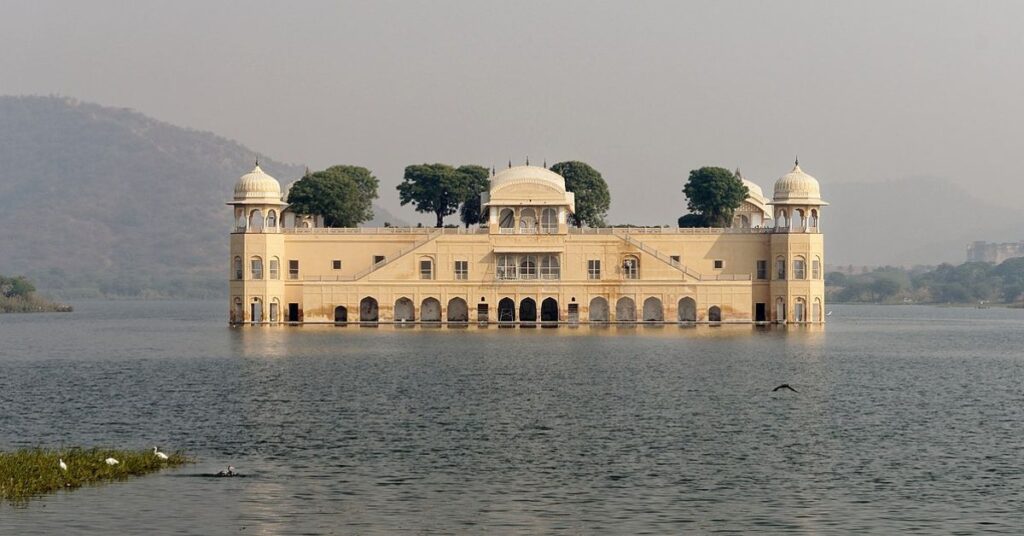
One of the most wonderful sights in Jaipur is the beautiful Jal Mahal or Lake Palace. The light, sand coloured stone walls and the deep blue of the water make for a wonderful contrast. The palace appears to float in the Centre of Man Sagar Lake, where its magnificent exteriors can be enjoyed by tourists.
Also Read: 30 Best Places to Visit in India In July
10. Sisodia Rani Palace and Garden
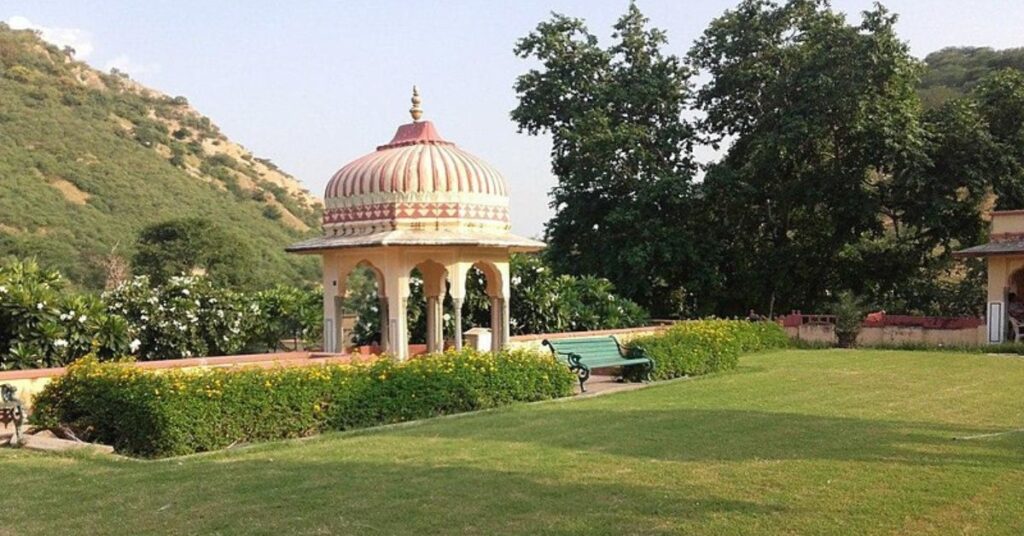
Sisodia Rani Garden in Jaipur is a historic garden built in the 18th century by Maharaja Sawai Jai Singh II for his queen. Adorned with fountains, pavilions, and vibrant murals depicting scenes from Lord Krishna’s life, the garden offers a serene retreat. It stands as a testament to Rajput architectural elegance, combining lush greenery with intricate design.
Sisodia Rani Garden and Palace have a popular space in the tourist section of Rajasthan as hundreds of people come to visit and enjoy the stunning beauty of a picturesque garden and the architectural brilliance portrayed on the palace walls.
It is located about 6 kilometers away from Jaipur city and was built by Maharaja Sawai Jai Singh II in 1728. It consists of tiered gardens with fountains, watercourses and colorful pavilions. If you are on a sightseeing in Jaipur, then this is one of the best places to visit in Jaipur.
The garden, as well as the palace, got their names as Sisodia Rani Garden and Palace from the queen for whom they were built and dedicated. She was from the Sisodiya line of Suryavanshi Rajputs who ruled the region of Mewar for a while.
Depicting a soothing blend of Mughal designs and Indian art style, the garden is a must visit tourist destination in Rajasthan now. The palace is situated on the top terrace of the garden.
There are temples of Lord Shiva and Hanuman placed inside the royal garden. It is marvelously embraced by lush green nature and splendid collection of rare flowers. The walls are painted beautifully that depict the stories related to Lord Krishna and Radha.
11. Galtaji Temple or Monkey Temple

Galtaji is an ancient pilgrimage Centre in Jaipur. Set amidst low hills and packed with locals and tourists alike, the attractive spot has temples, pavilions and holy kunds (natural springs and water tanks). Visitors to Galtaji will come across the complex of Ramgopalji temple, locally called the Monkey temple (Galwar Bagh).
It gets this moniker because of a large group of resident monkeys. The green landscape and chattering monkeys add to the delight of the area. On top of the hill is a small temple dedicated to the sun god, called the Surya Mandir. Constructed by Diwan Kriparam, the temple can be seen from anywhere in the city.
12. Panna Meena Ka Kund

Panna Meena ka Kund is a 16th-century stepwell located in Amer, a sub-city of Jaipur. It is one of the many stepwells that were built in Rajasthan to store water for drinking, irrigation, and religious purposes. Stepwells are unique architectural marvels that combine functionality and aesthetics. They are wells or ponds that can be accessed by a series of steps that descend from the ground level to the water level.
13. Gaitore ki Chhatriyan

Off the Jaipur-Amber road is Gaitore, where the former Maharajas of Jaipur are entombed. The chhatris (cenotaphs), made of white marble display the distinctive Rajput style of architecture. The open pavilions with ornate domes are supported by delicately sculpted pillars.
The crematorium is located in the middle of yellow sandstone hills. The décor and extravagance of a particular chattri is meant to reflect the stature and prowess of the ruler it contains.
The most graceful and beautiful chattri at Gaitor is that of Maharaja Jai Singh with 20 carved pillars. Tourists are especially drawn towards it because of its intricate carvings.
14. Rambagh Palace

Built in 1835, Rambagh Palace, Jaipur gracefully retains its elaborate splendor. Adorned with hand-carved marble latticework, sandstone balustrades, and lush Mughal Gardens, it once served as a royal guesthouse and hunting lodge. From the Maharaja’s residence to an authentic palace, this palace hotel in Jaipur upholds its ceremonial grandeur for all guests.
Among its many renowned restaurants is Suvarna Mahal, housed in the 18th-century-styled palace ballroom, offering Royal Indian delicacies.
15. Bapu Bazar

Bapu Bazar is fun and lively with lots of stores selling costume jewelry, scarves, clothing and handicrafts. It is ok to bargain a little. I bought a couple of colorful scarves and costume jewelry bracelets.
Located in the heart of Jaipur city, between the Sanganer Gate and the New Gate of the Pink City, Bapu Bazar is a one stop destination for shopping.
16. Amar Jawan Jyoti
The Amar Jawan Jyoti, or the ‘flame of the immortal soldiers’, is a memorial dedicated to the martyrs of Rajasthan. This memorial is situated near Jaipur’s Vidhan Sabha Bhawan (Legislative Assembly).
The key attraction of the Amar Jawan Jyoti is that the torches at the four corners of the structure are always burning. In evenings, this formidable structure is attractively lit up in vivid colours. The brilliant lighting effects make this a picturesque spot a favourite with tourists.
17. Raj Mandir Cinema

Established in 1976, Raj Mandir Cinema is one of the most famous spots in Jaipur is the Raj Mandir Cinema. A single-screen experience, done up with a royal and luxurious architecture, the cinema holds a special place in the Pink City. Watching a Hindi movie is an amazing experience at this cinema, and booking your seat in advance is always a good idea.
An asymmetrical exterior design helps the theater stand apart. Inside, the extravagantly finished roof, grand chandeliers, and a rising staircase next to the lobby lend an old world charm to the place. Located just off MI road, a Jaipur trip cannot be considered complete without a visit to the Raj Mandir.
18. Jawahar Circle
Located near the Jawaharlal Nehru Marg in the Pink City, Jaipur, the Jawahar Circle is a unique destination for all kinds of visitors. Honored as the largest circular park in Asia, Jawahar Circle is encompassed by a rose garden and offers a number of concentric jogging tracks, benches, and lush greenery.
While the beautifully landscaped plantations and green areas of the park are enough to leave a visitor awed, the main attraction of the park has definitely got to be the Musical Fountain. The fountain creates spectacular shows with over 270 types of effects and over 300 colorful lights.
Sometimes, the height of the water of the musical fountain reaches up to 25 feet as well. While Jawahar Circle is a delight to be in to spend a day relaxing amidst nature, it gets even better in the evening hours. Artfully lit up, the musical fountain show is a 30-minute treat that begins at 7 in the evening, and is something that simply cannot be missed.
19. Jawahar Kala Kendra
The Jawahar Kala Kendra, more popularly known as the JKK, is an international institution that focuses on preserving and promoting the different genres of Indian culture and art. Established in Jaipur in the year 1993, the Jawahar Kala Kendra has become a very popular cultural destination in the city.
JKK facilitates a lot of artists, artisans, scholars, art-connoisseurs, and visitors to interact with each other. The center portrays the nuances of Indian art and culture, through a number of activities like art exhibitions, theater shows, dance and music recitals, and workshops, helping people observe the intrinsic aspects of Rajasthani and Indian culture.
JKK has been built on a theme of the nine planets, or the navgraha concept of Indian astronomy. With six exhibition galleries, dormitories, auditoriums, and an open house theater, the JKK also has its own Shipgram complex that has six huts that represent the rural aspect of the state and are the venue for haat bazaars, festival, and fairs. It also houses the Indian Coffee House, a restaurant very popular among the locals & visitors alike.


